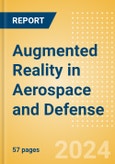A key driver in the widespread adoption of this technology is Microsoft’s AR headset, the HoloLens, which can be modified with specialized software to adapt to different scenarios. The integrated visual augmentation system (IVAS) is an AR heads-up display (HUD) based on the HoloLens that the US Army commissioned from Microsoft in a $21.9 billion deal in 2021. Major defense contractors are also active in developing AR. For example, Elbit Systems has created several AR products for battlefield applications and training initiatives. Similarly, BAE Systems developed AR smart glasses in 2019 that use free-space tracking technology to display guidance, targeting, and mission-specific data to the wearer.
According to the publisher forecasts, the AR market will be worth $100 billion by 2030, up from $22 billion in 2022. AR software will generate most of this revenue, with limited spending on AR headsets and AR smart glasses.
Key Highlights
- Studies of emerging technological trends and their broader impact on the defense market.
- Analysis of the various augmented reality programs and projects currently under development, as well as the diverse range of applications and use cases for this technology in both the civil and military domains.
Scope
- The key defense challenges that forces and defense sector suppliers face are covered.
- The investment opportunities for armed forces, suppliers, and institutional investors, across the whole augmented reality technology value chain are covered.
- Highlights from the range different augmented reality related research and development programs currently being undertaken by various military organizations and defense companies.
Reasons to Buy
- Determine potential investment companies based on trend analysis and market projections.
- Gaining an understanding of the market challenges and opportunities surrounding the augmented reality in aerospace and defense theme.
- Understanding how spending on augmented reality and related segments will fit into the overall market and which spending areas are being prioritized.
Table of Contents
- Executive summary
- Players
- Defense Challenges
- The Impact of Augmented Reality in Defense
- Case Studies
- Augmented Reality timeline
- Market size and growth forecasts
- AR software
- AR hardware
- Signals
- M&A trends
- Patent trends
- Company filing trends
- Hiring trends
- Augmented Reality value chain
- Semiconductors
- Components
- Devices
- Platforms
- Apps and content
- Companies
- Leading AR adopters in defense
- Leading AR vendors
- Specialist AR vendors in defense
- Sector Scorecards
- Defense scorecard
- Glossary
- Further reading
- Thematic Research Methodology
- About the Publisher
- Contact the Publisher
- Key players in augmented reality
- AR-related social media mentions in the defense sector
- Thematic investment matrix
- Red 6’s ATARS AR training mission
- The US Army’s IVAS 1.2
- BAE Systems’ Project Odyssey
- AR will become a $100 billion market by 2030
- Enterprise AR will continue to be more lucrative than the consumer market by 2030
- AR software will dominate the market over the forecast period
- The AR software market will generate $82 billion in revenue by 2030
- The AR hardware market will be worth $18 billion by 2030
- AR headsets will lead the AR hardware market
- AR-related patents in defense grew between 2003 and 2022, but declined in 2023
- Aerospace is the leading sector for AR-related patents, while the US dominates the publication counts
- Safran had the most mentions of AR in company filings
- AR-related active jobs in the ADS sector peaked in July 2023
- The augmented reality value chain
- AR value chain - Semiconductors
- AR value chain - Components
- AR value chain - Devices
- AR value chain - Platforms
- AR value chain - Platforms - AI
- AR value chain - Apps and content
- Sector scorecard - Companies
- Sector scorecard - Thematic
- Sector scorecard - Valuation
- Sector scorecard - Risk
- Defense challenges
- M&A Deals
- Leading augmented reality adopters in defense
- Leading augmented reality vendors
- Specialist augmented reality vendors in defense
- Glossary
- Further reading








